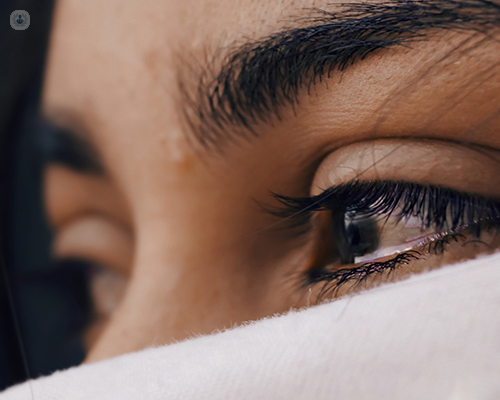An expert guide to tear duct surgery
Autore:What is lacrimal, or tear duct surgery?
Patients who have watery or sticky eyes may opt for surgery. Watery eyes may not seem like a big deal but in fact it’s a very big problem for patients, particularly if they’re trying to read because the water wells up in their eyes. When they try to look at something it’s as if they’re looking through a swimming pool.

There are lots of different causes and treatments for watery eye, which require a thorough investigation and a management plan. Treatment can range from the minimalist intervention of cleaning up the eyelids and treating underlying blepharitis and mid hygiene issues to quite significant major surgery that can take up to an hour to do.
There is a broad suite of problems that are encompassed by watery eye. It can affect a broad range of age groups, from newborn babies to 95 year olds.
What can happen if a tear duct goes untreated? Are there non-surgical options?
A watery eye isn’t serious but it’s a lifestyle problem and there are a few reasons why you would want to intervene.
Firstly, if patients are getting recurrent infections in the tear sac (dacryocystitis) they will often opt for treatment.
Secondly if patients have got sticky, watery eyes and have cataracts, an opthamologist will not want to treat a cataract until a sticky eye is dealt with. This is because the stickiness is a risk for infection. Until the risk of infection is taken away, the cataract will not be performed.
Some patients are not bothered by watery eyes but if left untreated, they will require cataract surgery. Therefore it is better for patients to have surgery rather than leaving it alone, because if they wait until they’re older they will be less fit for anesthesia.
In general, there are a few reasons to intervene, including symptoms, lifestyle, inability to read and social embarrassment from looking like you’re crying the whole time.
Another reason to interevne is due to the sticky eye that keeps getting infected or a sticky eye that might be heading towards cataract surgery.
Is lacrimal surgery a risky procedure?
All surgery carries risk. The tear duct surgery is usually done under general anaesthetic, therefore posing an anesthetic risk, alongside potential risks surrounding blood thinners and whether or not to stop them.
In terms if the surgery itself, there’s about a 95%+ / 19 out of 20 success rate, meaning that there is a 1 in 20 failure rate. This is the biggest risk in terms of statistics.
In terms of medical risk, the main risk is bleeding because it is nasal surgery.
There are small risks associated with the surgery where there can be problems with the CSF (the liquid that bathes the skin) leaking .
Overall, it’s a safe surgery and the risks are associated with anesthesia and being fit for it.
Is lacrimal surgery painful?
Lacrimal surgery generally is not painful. Doctors will usually will add a patch to the patient’s eye post surgery, which is removed in the morning, primarily to reduce the bruising and swelling.
Following surgery, patients will go home with eye drops and nasal inhalers.
Many doctors do not prescribe painkillers after lacrimal surgery. If painkillers are prescribed, they will not be stronger than paracetamol or tylenol.
How long does it take to recover from lacrimal surgery?
After DCR (tear duct surgery) doctors recommend that patients do not bend down or lift anything too heavy, due to risk of bleeding, for a week and they will ask patients to not to blow their nose for two weeks.
Bruising is usually gone by a week to two weeks and the tubes that are left in the tear duct system, to help it shut again, are removed at about six weeks time in the outpatient clinic. Doctors snip the tubes and ask patients to blow them out (when they blow their nose).
In general, recovery is a couple of weeks. It is recommended that you take a couple of weeks off work.
The incision tends to heal very well. There are papers which show that 1 in 20 people notice the incision after surgery but it’s not a common problem. Particularly patients of that age tend to wear glasses where the incision sits.


